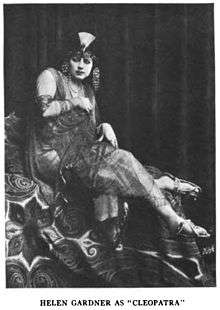Cleopatra (1912 film)
| Cleopatra | |
|---|---|
 | |
| Directed by | Charles L. Gaskill |
| Produced by | Helen Gardner |
| Based on |
Cléopâtre by Victorien Sardou |
| Starring | Helen Gardner |
| Cinematography | Lucien Tainguy |
| Edited by | Helen Gardner (uncredited) |
Production company |
The Helen Gardner Picture Players |
| Distributed by |
United States Film Co. (1912) Cleopatra Film Co. (1918 re-release) |
Release dates |
|
Running time | 88 minutes |
| Country | United States |
| Budget | $45,000 |
.webm.jpg)
Cleopatra is a 1912 American silent historical drama starring Helen Gardner in the title role and directed by Charles L. Gaskill. It is the first film to be produced by Gardner's production company, The Helen Gardner Picture Players. The film was based on a play written by Victorien Sardou.[1]
Cleopatra is one of the first six-reel feature films produced in the United States.[2] Promoted with the tagline "The most beautiful motion picture ever made", the film was the first to offer a feature-length depiction of Cleopatra,[3] although there had already been a short film about Antony and Cleopatra earlier.[4]
Synopsis
In a series of elaborately staged tableaux, it depicts Cleopatra and her love affairs, first with handsome fisherman-slave Pharon, then with Mark Antony.
Cast
- Helen Gardner as Cleopatra - Queen of Egypt
- Mr. Howard as Pharon - A Greek slave and fisherman
- Charles Sindelar as Mark Antony - Triumvir and General
- James R. Waite as Venditius - A Roman soldier
- Mr. Osborne as Diomedes - A rich Egyptian
- Harry Knowles as Kephren - Captain of the Guards to the Queen
- Mr. Paul as Octavius - A Triumvir and General
- Mr. Brady as Serapian - An Egyptian priest
- Mr. Corker as Ixias - Servant to Ventidius
- Pearl Sindelar as Iras - An attendant
- Miss Fielding as Charmian - An attendant
- Miss Robson as Octavia - Wife of Antony
- Helene Costello as Nicola - Child
Production notes
Cleopatra was the first film produced by Helen Gardner's production company, The Helen Gardner Picture Players, located in Tappan, New York.[5] Gardner created the company in 1910 after finding success in a series of Vitagraph shorts in the early 1900s.[2]
The film's budget was $45,000 (approximately $1,185,000 today) and featured lavish sets and costumes (Gardner also served as the film's costume designer and editor). In an unusual move for the time, Gardner used the natural scenery in Tappan for outdoor shots in addition to sets.[2][3]
Releases
Upon its release, Cleopatra played in opera houses and theatres. The film was also featured in a theatrical roadshow accompanied by a publicist, manager and a lecturer/projectionist.[6]
In 1918, Gardner filmed additional scenes and re-issued the film to compete with the 1917 adaptation released by Fox and starring Theda Bara.[6]
Reception
Like many American films of the time, Cleopatra was subject to cuts by city and state film censorship boards. For the 1918 release, the Chicago Board of Censors required a cut of the two intertitles "If I let you live and love me ten days, will you then destroy yourself?" and "Suppose Anthony were told that she had just left the embraces of the slave Pharon".[7]
Status
The 1912 version of Cleopatra still exists in its entirety. Turner Classic Movies had the print restored and commissioned a new musical score for the film. The restored version aired on TCM in August 2002.[2]
References
- ↑ Ball, Robert Hamilton (2013). Shakespeare on Silent Film: A Strange Eventful History. Routledge. p. 19. ISBN 1-134-98098-1.
- 1 2 3 4 Wallace Dickinson, Joy (March 25, 2001). "Early Screen Queen Turns Heads Again". orlandosentinel.com.
- 1 2 Wallace Dickinson, Joy. "Few Remember Days When Film Queen Lived Among Us". orlandosentinel.com. p. 1.
- ↑ "Cléopâtre (1910)". IMDB.
- ↑ Everson, William K. (2009). American Silent Film. Da Capo Press. p. 57. ISBN 0-786-75094-4.
- 1 2 McCaffrey, Donald W.; Jacobs, Christopher P., ed. (1999). Guide to the Silent Years of American Cinema. Greenwood Publishing Group. p. 81. ISBN 0-313-30345-2.
- ↑ "Official Cut-Outs by the Chicago Board of Censors". Exhibitors Herald (New York City: Exhibitors Herald Company) 6 (3): 31. January 12, 1918.
External Links
- Cleopatra on YouTube
- Cleopatra at the Internet Movie Database
- Cleopatra at silentera.com